MYTHLOGIC Pollux 1400: Clevo's W150HR Tested
by Jarred Walton on August 23, 2011 12:00 AM ESTBattery Life and Power: Not a Strong Showing
We’ve reviewed so many Optimus enabled laptops during the past year that we generally know what to expect. For our battery life tests, the discrete GPU should never have to activate, leaving all of the graphics duties to the Intel IGP. Even without the dGPU coming into play, there are still differences between laptops, and unfortunately this is a weak spot for the Clevo W150HR. We calibrated for 100 nits on the LCD, which came out to a setting of 28% in Windows’ power settings (two steps up from minimum on the LCD brightness scale). We also tested both the Bigfoot-equipped W150HR and the Intel 6230-equipped W150HR in the Internet test (the WiFi connection is turned off for the Idle and H.264 tests). Keep an eye on the Dell XPS 15, as that’s roughly where we’d like to see the W150HR in the charts.
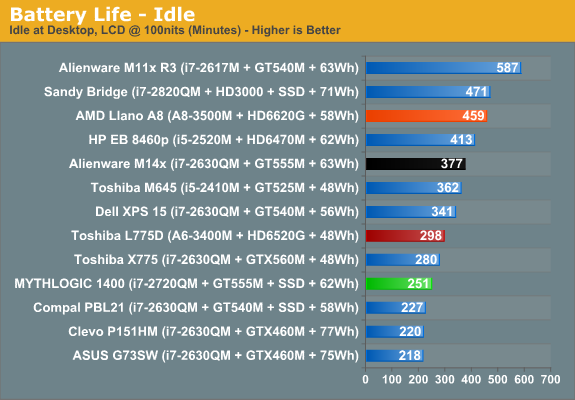
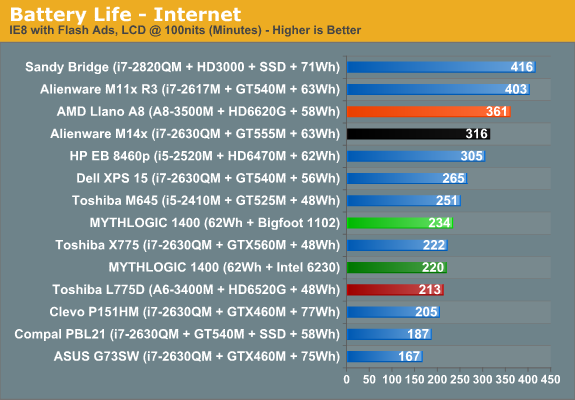
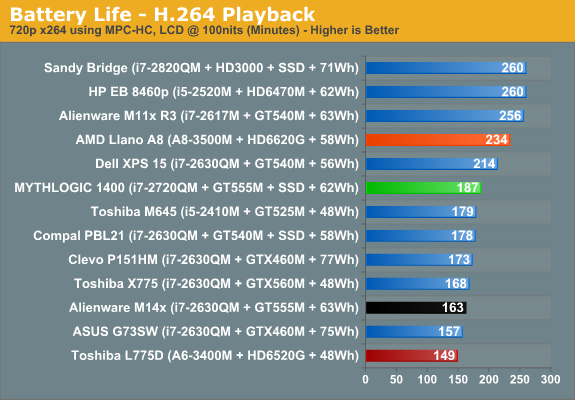
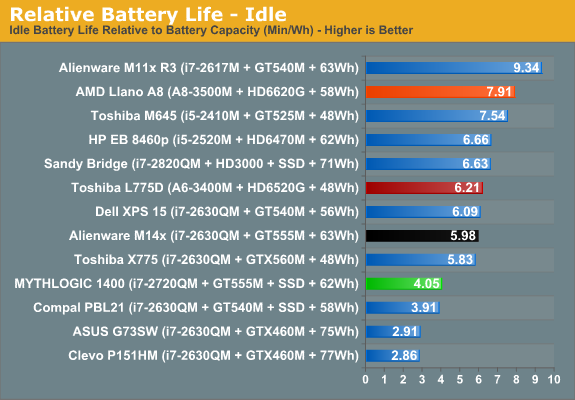
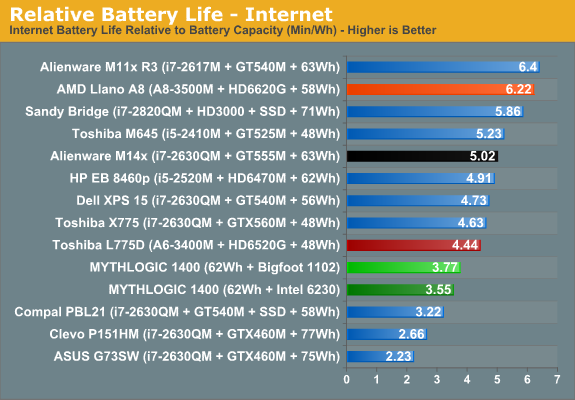

As we were saying, the results are less than impressive. When Toshiba’s X775 can pack in a 17.3” LCD and a GTX 560M GPU with a paltry 48Wh battery and still come out ahead in the idle test, that’s not good. Looking at the Dell XPS 15, with a 56Wh battery and a similar LCD it manages to best the W150HR by 36% at idle, 13% in the Internet test, 14% in the H.264 test. Accounting for battery capacity, the only Optimus laptop that does similar/worse is the Compal PBL21. (There was a flaw with the H.264 playback result on the Alienware M14x, where a recent Optimus profile update switched MPC-HC to running on the dGPU by default; it did much better in the other two tests and should be around the level of the XPS 15 in the H.264 test.)
Calculating power draw, we get a minimum idle power use of 14.4W for the Clevo W150HR, which is far higher than most similar notebooks. The XPS 15 idles at 9.6W, the Alienware M14x at 9.7W, and even the behemoth Toshiba X775 sits at 10.0W. The Compal PBL21 incidentally is also at 14.9W—anyone else get the impression that major OEMs are better at optimizing laptops for battery power than ODMs like Clevo and Compal?
Also worthy of note is the Internet test with the two different WiFi adapters. We already posted our full review of the Bigfoot 1102, where we came to the conclusion that it was a better WiFi solution than Intel’s Advanced-N 6230 and very competitive with the Intel Ultimate-N 6300. We were curious what sort of difference we’d see in battery life, like many of our readers, and the result puts the Bigfoot 1102 in an even better light: better throughput, substantially better latency, and lower power use compared to the Intel 6230. We disabled the Bluetooth support on the 6230, but it might still draw power, as our calculations peg the BF 1102 notebook at ~15.4W during the Internet test compared to ~16.4W for the Intel 6230 notebook. 1W is a huge difference for just a change in WiFi adapter, and we tested with the same battery; however, we did not test in the same chassis so the Intel notebook might simply have a few other components (e.g. the CPU and chipset) that are drawing slightly more current.










22 Comments
View All Comments
CAndrews - Tuesday, August 23, 2011 - link
Is a review of the W520 coming?JarredWalton - Tuesday, August 23, 2011 - link
Sadly, no. Lenovo has not sent any review samples to us for a couple years.TotalLamer - Tuesday, August 23, 2011 - link
Oh really... ? What did you guys do to piss in their Cheerios? Haha.But on another note... any chance of a review on the 3830TG you mentioned? It's a nice looking machine and seems like the only notebook that can even come close to competing with everything you can get in a Sony Vaio SA (except for the 1600x900 display) but I've heard not-so-nice things about the heat dissipation
JarredWalton - Tuesday, August 23, 2011 - link
Yes, I'm working on the review. And it really *is* a nice looking machine with no major issues so far. I haven't tried stress-testing it for heat yet, and that may be the one area where it has some problems. We'll see.TotalLamer - Tuesday, August 23, 2011 - link
Yeah... I've heard there's throttling. Lots and lots of throttling. BAD throttling.JarredWalton - Tuesday, August 23, 2011 - link
I thought I saw something stating the GPU speed was 600MHz at one point when I was messing around (instead of the normal 672MHz of the GT 540M). Considering the dimensions of the chassis, I was actually quite shocked that they have the 540M in there.hybrid2d4x4 - Tuesday, August 23, 2011 - link
I briefly had the lowest-end config with the 2310 cpu and it throttled down to 1.3GHz under Prime95 without anything stressing the GPU, so I'm pretty sure I know what result you'll get, Jarred.Still, at $600 you get a really good feature set and hardware for the money but the quality control is non-existing. Of the 3 I had, 2 had corruption in HDMI output that made it unusable and 1 had half the keyboard keys not working. Going to play the lottery some more today to try and get a working one...
rallstarz - Tuesday, August 23, 2011 - link
Thanks for the review! I am trying to decide between the W150HR and the Dell XPS 15. Since I don't much mind for limited battery life and don't mind so much the nonstandard keyboard, it seems that the Clevo gives the best bang for the performance buck. My only concern is the longevity of the laptop. Do you know if pushing the thermal specs will significantly decrease longevity? Also (and I know you touched on this) for general use/gaming, does the system hit max cpu load for an extended period of time, or is your "worst-case" scenario truly a situation that the system does not generally hit?mythlogic - Tuesday, August 23, 2011 - link
Hey, I carry around one of these for my own use. It only gets REALLY hot (and never ever really hits 100 under "normal use") when i'm gaming on it, but just sitting on my lap its never too bad, or on a desk.JarredWalton - Tuesday, August 23, 2011 - link
Playing a game for a couple hours, you can expect to hit CPU temperatures of around 90-94C, which is hot but not quite 100C.